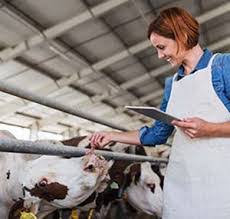In this article, the objectives of farm management are discussed. The central issue in any economic analysis is the problem of limited resources, or resource scarcity. The ability of any society or producer to produce depends on the availability of resources.
Since resources are limited or scarce in all societies, available resources must be allocated in the most efficient way. Efficient allocation of resources means that the society or producer must organize available resources and determine their priority uses in the best way possible.
The Farm as a Production Sub-System
In farm management analysis, a farm as a whole is considered the unit for decision-making because the objective is to maximize returns from the entire farm rather than improving returns from a single enterprise or practice.
No agronomist will advise a farmer on how to utilize surplus labor and scarce capital by taking up supplementary enterprises. Sciences like horticulture and dairy are similarly concerned with only one aspect of the farm business. Farm management, however, considers all possible aspects and enterprises for the farm as a unit.
Farm management does not focus solely on one profitable enterprise but on the most profitable enterprise combinations to achieve maximum income from the farm as a whole on a continuous basis. It exploits the advantages of complementarity and supplementarity in farm enterprises.
It is more concerned with total crop productivity rather than the productivity of a single crop. A farmer may be recognized for achieving the highest per-acre yield of a particular crop but may still earn less than an average farmer in his group.
This is because the farmer may allocate most resources to one crop and one plot instead of using each unit of labor and other resources where it adds the most to returns. This is especially true where many farm resources are limited.
The principles of farm management help achieve the optimum enterprise mix that yields the highest income to the farmer from his total farm organization. The farm is a production subsystem in an economy and is normally identified as a business venture.
Resources, also known as inputs or factors of production, combine to produce outputs such as crops and livestock products. Farm resources include land, labor, capital (farm tools, equipment, chemicals like fertilizers and herbicides), financial inputs (loans, cash, remittances), management (skills to manage), and technology (new varieties, innovations, or ideas).
The ability of a society or producer to organize and allocate resources efficiently depends on their management capacity. Management is concerned with decision-making. Like any business venture, the farmer is the manager of a farm business and decides how best to use limited resources.
Read Also: Rabbit Hutch Equipment and Requirements
Applying Economic Principles in Farm Management

Applying economic principles in the art of managing a farm business is known as farm management. This involves the farmer’s ability to organize and manipulate resources to his advantage, controlling and determining the relationship between input and output, even when the exact conditions of the farm production environment are not fully known.
The allocation of limited resources among alternative uses requires a manager to make decisions. Without decisions, nothing would happen. Even allowing things to continue as they are implies a decision, perhaps not a good one, but a passive decision nevertheless.
The process of making a decision can be formalized into a logical and orderly series of steps. Important steps in the decision-making process include:
1. Choosing Between Alternatives: Choosing the best solution to a problem is not always easy, nor is the best solution always obvious. Sometimes the best solution must be selected from a chain of alternatives. The future implications of any decision should be carefully considered before taking action.
2. Taking Action: Recognizing problems, gathering information, specifying alternatives, and making decisions are worthless steps unless followed by purposeful action. This means the manager must act based on his analysis of the problem rather than blindly following others.
3. Evaluating Consequences: After acting on a problem, the outcome may be good or bad. The initial problem may or may not be solved. Either way, new problems will arise, requiring the decision-making cycle to start again. By reviewing the outcome of his decision, the manager can gain experience and improve his ability to make better decisions in the future.
4. Bearing Responsibility: Responsibility and management go hand in hand. A good manager is willing to face issues and take decisions. Avoiding responsibility for past decisions and actions means shifting blame or withdrawing from the managerial role. A manager who blames failures on bad luck never learns from past mistakes and continues to make poor decisions or avoids making decisions altogether.
The exact and full knowledge about a farm situation is not always possible. However, the farmer must make decisions, even if they may turn out to be wrong. The art of management involves minimizing the possibility of wrong results by using past information, experiences, and advice from experts or extension advisors.
A good manager is flexible and responsive to changes to avoid poor outcomes. Success in farm management requires the farmer’s capacity and ability to make correct decisions. Decision-making is one of the crucial functions of a farm manager. The total system can be improved and streamlined through research and educational programs.
Classification of Decisions

Decisions can be classified based on:
1. Importance: The importance of a decision is measured by the size of the potential gain or loss involved. For example, the decision to engage in poultry farming is more important than the choice of bird breed.
2. Frequency: Some decisions are made once in a lifetime, such as choosing farming as a vocation. Others, like livestock feeding times or the amount of feed to be given daily, must be made frequently. These decisions can be routinized by developing a plan at the beginning of the period and sticking to it until conditions change.
3. Imminence: Some decisions must be made quickly to avoid potential losses, such as weeding and fertilizer application. Others have no deadline, and delaying the decision may not result in penalties.
4. Revocability: Some decisions can be easily reversed, such as changing a livestock feed ration. Others, like planting oil palm on a piece of land, are irreversible or can only be changed at a high cost.
5. Available Alternatives: Some situations offer many choices, while others provide only a few. When multiple choices are available, techniques must be developed to eliminate less likely options and focus on a few workable alternatives for careful study and analysis.
Objectives of Farm Management
Successful farm management requires the farmer’s ability and capacity not only to make decisions but to make the correct decisions. To improve management ability, one needs a process model to understand what needs improvement.
Eight processes or functions have been proposed by Nielson:
1. Formulation of Goals or Objectives: Defining the goals of the farm business.
2. Recognition and Definition of Problems or Opportunities: Identifying and defining problems or opportunities.
3. Obtaining Information: Gathering relevant facts and observations.
4. Specification and Analysis of Alternatives: Identifying and analyzing possible solutions.
5. Decision-Making: Choosing the best alternative.
6. Taking Action: Implementing the chosen solution.
7. Bearing Responsibility: Accepting responsibility for the decision and its outcomes.
8. Evaluating the Outcome: Reviewing the results to learn and improve future decisions.
A manager may not always follow these steps systematically, but studying this model is useful for understanding the process.
Since management functions are primarily a mental process, each choice and action is influenced by the manager’s attitudes, values, and goals.
These goals and value systems unconsciously determine what the manager observes, considers, gathers, and chooses. Thus, formulating clear goals is essential for effective management, as they provide direction to the entire process.
Problems need to be recognized and defined to produce acceptable results. Research shows that identifying problems in farm businesses is surprisingly difficult for farmers. Problems are recognized through:
- A forced action situation.
- Systematic study of farm operations.
- Ordinary opportunities for action. Good managers identify more problems through systematic farm-business analysis.
Decision-making is a crucial function of management. Decisions can involve taking no action, seeking more information, or choosing a different course of action. Successful farm managers prefer to try alternative actions within reasonable risk limits.
Good managers not only have the will and capacity to get the job done but also the fortitude to bear responsibility for their actions. Evaluation is similar to searching for alternative courses of action, where management performs the role of scientific inquiry and analysis.
The managerial process can be improved through research and educational programs. Management remains an art in making choices, taking action, and bearing responsibility. In practice, management is a continuous process involving observation, analysis, decision-making, action, and responsibility.
Management can be distinguished from entrepreneurship. Entrepreneurship involves pioneering, founding, and developing activities, while management involves running an established business. Most farmers function in both capacities. A third category, the executive, carries out the orders of management.
Read Also: Types of Rabbit Housing
Central Objectives of Farm Management

The central objectives of farm management are to increase the efficiency with which farm production resources are used in producing farm enterprises to maximize profit. While farmers differ in values and aspirations, profit maximization is often considered the ultimate goal from an analytical perspective.
This assumption, borrowed from economic theory, is reasonable because profitable farm businesses generate capital for investment and expansion, in addition to providing food and fiber.
However, it is not unusual for a farmer to aim for less than maximum profit due to constraints or special circumstances. For example, religious beliefs may prevent a Muslim farmer from rearing swine. A less profitable enterprise may be included to meet family consumption needs. Thus, non-monetary factors may override the profit maximization assumption in farm management.
In summary, the objectives of farm management may include:
1. Profit Maximization: Achieving the highest possible profit.
2. Cost Minimization: Reducing production costs.
3. Market Leadership: Controlling a significant share of the market.
4. Utility Maximization: Maximizing satisfaction or utility.
This article has discussed the farm as a production subsystem and the objectives of farm management. The central goal is to maximize efficiency and profit while considering constraints and non-monetary factors. Farm management involves decision-making, resource allocation, and continuous improvement through research and education.
Do you have any questions, suggestions, or contributions? If so, please feel free to use the comment box below to share your thoughts. We also encourage you to kindly share this information with others who might benefit from it. Since we can’t reach everyone at once, we truly appreciate your help in spreading the word. Thank you so much for your support and for sharing!
Read Also: Operation and Maintenance of Grit






